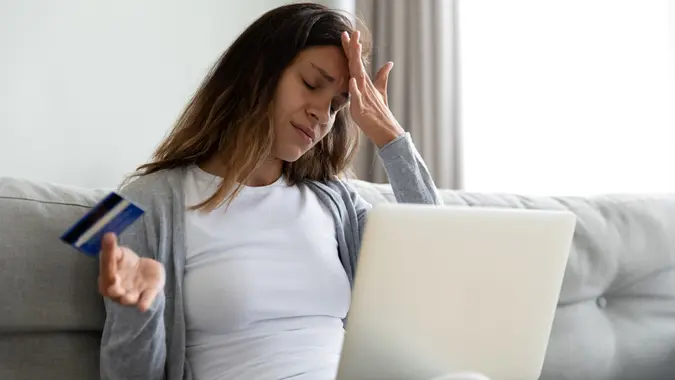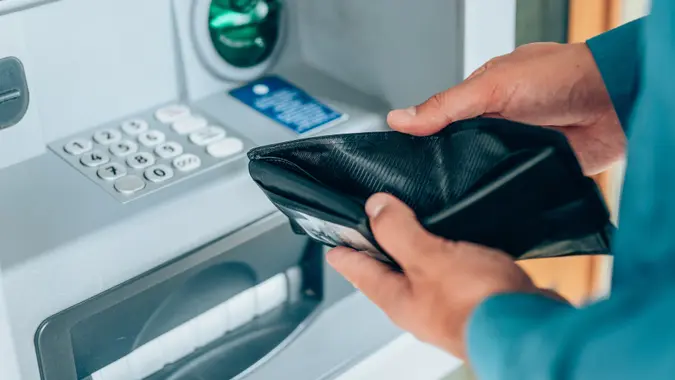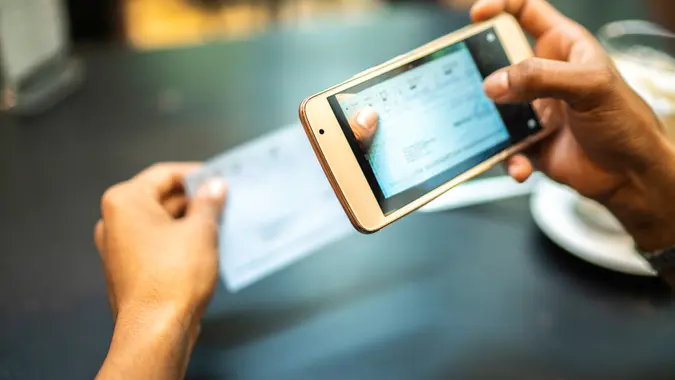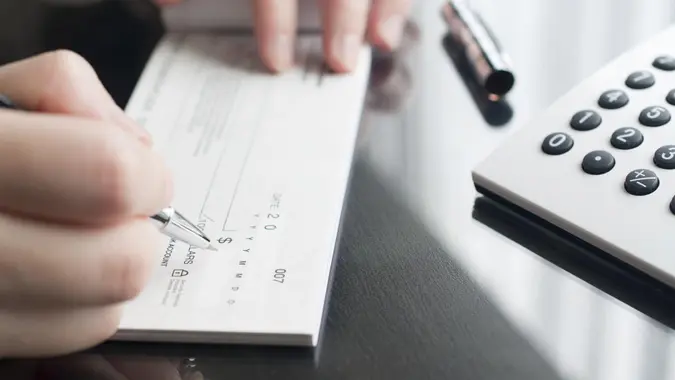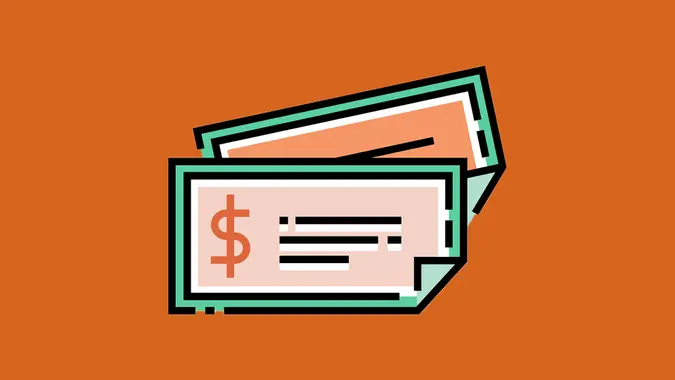How To Fill Out a Money Order: Step-by-Step Guide

Commitment to Our Readers
GOBankingRates' editorial team is committed to bringing you unbiased reviews and information. We use data-driven methodologies to evaluate financial products and services - our reviews and ratings are not influenced by advertisers. You can read more about our editorial guidelines and our products and services review methodology.

20 Years
Helping You Live Richer

Reviewed
by Experts

Trusted by
Millions of Readers
Money orders are a secure and convenient way to make payments, especially if you don’t want to open a bank account or prefer not to use checks or cash. They are widely accepted and can be purchased from various locations, including post offices, banks and retail stores. If you’re new to using money orders, don’t worry — filling one out is a quick process.
How To Fill Out a Money Order: 5-Step Guide
You can use the following steps if you need to know how to fill out a money order from Western Union, the post office or any other issuer.
Step 1: Write the Recipient’s Name
Write the recipient’s name in the “pay to” or “pay to the order of” section as soon as you get the money order. If it’s left blank and then lost or stolen, the wrong person may fill their own name in the recipient field and cash it.
Good To Know
Some money orders also have a line for an address. But, what address do you put on a money order? It depends on the form.
Some money orders ask for the purchaser’s address, others for the recipient’s — and some for both. Double-check the labels to enter the correct one.
Step 2: Add Your Name as the Purchaser
Fill in your name and, if there’s a line for it, your address in the purchaser’s section. The section for your information could be labeled “purchaser,” “from,” “sender” or “remitter.”
You may think this information is unnecessary. However, if you’re paying a bill, you want to ensure the biller has enough information to credit the payment to your account or to contact you if there is a problem.
Step 3: Fill In the Memo Section
Some money orders have a memo line like checks do, so you can include a note or your bank account number if you’re paying a bill.
Once again, provide enough information to ensure that the biller has no questions regarding which account to credit.
Step 4: Sign Your Name
If required, sign the front of the money order. The line will say “purchaser’s signature” or something similar.
The back of the money order is saved for the recipient. That is where they will sign to confirm its receipt just as if they were cashing a check.
Keep In Mind
You might sign the back of a money order only if you’re making one out to yourself. In that case, check with your bank before depositing it via mobile deposit — not all banks allow it.
Make sure you double-check the money order before handing it over or mailing it.
Step 5: Keep the Receipt
Once completed, you can detach the receipt from the money order, and keep it in a safe place in case you need to get a refund for it. This is good to have in case you fill it out incorrectly or there are other issues with the transaction.
If you alter it in any way to fix it, your recipient may not be able to cash it. However, if you have the receipt, you can get a replacement money order. You’ll also need the receipt to replace a lost or stolen one.
If you don’t have the receipt, you can request a refund from most issuers. Keep in mind, receiving a refund can take as long as 60 days. If the money order is cashed during that time, you may have to show proof of fraud to get your money back.
Key Points To Know About Money Orders
- You may need to know how to fill out a money order if you’re making a cash deposit on an apartment, sending money to family outside of the U.S. or wanting to keep your banking information private during a purchase.
- The maximum money order amount varies by issuer. For example, the biggest money order you can get at the post office is $1,000. However, some issuers may have a lower cap.
- To protect against fraud, financial institutions may not cash a money order missing essential information, like the recipient’s name or the purchaser’s signature.
- If you’re paying a bill, the biller may not accept an incomplete money order either. Be sure to complete all fields to prevent problems or delays.
Where To Buy a Money Order
You can buy money orders at many locations, including:
- Your bank or credit union
- The post office
- Western Union and MoneyGram locations
- Convenience stores, grocery stores, big-box stores and drug stores offering Western Union or MoneyGram services
Common Uses for Money Orders
Money orders make financing more accessible to people who do not have bank accounts. These are some of the common ways people use money orders:
- Sending payments to people who do not have bank accounts.
- Paying for rent, utilities or legal obligations.
- Secure transactions for online purchases.
- Sending money internationally — exchange rates impact the total cost. International money orders may take longer to deliver and have higher fees.
Money Order Mistakes To Avoid
Most money order mistakes come down to filling out inaccurate information.
- Some people might write the recipient’s name incorrectly or leave the amount or fields blank.
- It’s also common for people to lose the receipt or tracking number.
- If you make any errors on your money order, don’t use white-out or scribbles. Get a new money order instead and start fresh.
5 Alternatives To Using a Money Order
If using a money order isn’t the right option for you, consider these options for sending money:
- Cashier’s checks: They are available from your bank or credit union, sometimes for a fee.
- Zelle: This app allows you to send money from your bank account to someone else’s, often without a fee.
- PayPal: You can use this payment platform to send money to family or friends.
- Venmo: This app has social features and makes it easy to send money to people you know.
- Online bill pay: This free service is often available through the online banking platforms of banks or credit unions.
Conclusion
Because of the many ways you can send money without using a checking account, you might not have much need for money orders. But, for those times you need to use one as a secure payment method, you’ll want to know how to fill out a money order correctly to ensure the recipient can cash it.
Filling out the money order completely and double-checking it for accuracy can lead to a smooth experience. Always keep your receipt in case you need to request a replacement or refund.
FAQ
Here are the answers to some of the most frequently asked questions regarding money orders.- Where can I buy a money order, and how much does it cost?
- You can buy a money order at a bank, credit union or post office. Some convenience stores and grocery stores also offer money orders. The cost of a domestic money order usually ranges from $1 to $5, while international orders are more expensive.
- Can I cancel a money order after it has been purchased?
- You can cancel a money order after it has been purchased as long as it hasn't been cashed yet. You will have to contact the issuer to start the cancelation process.
- What happens if I lose the receipt for my money order?
- If you lose the receipt, you may be able to get new tracking for a fee. However, some money orders are unretrievable if you've lost them, so you have to get them replaced or refunded.
- How do I know if a money order is legitimate?
- You can check a money order's security features, such as the letters "USPS" and a watermark of Benjamin Franklin.
- Can I make changes to a money order after filling it out?
- No. You cannot make any changes to a money order once you have filled it out. You will have to replace the money order with a new one.
- Are there limits on how much money can be sent through a money order?
- You can send up to $1,000 with a single domestic money order. However, you can pursue multiple money orders on the same day to circumvent the limit. Even then, issuers often place limits on how many money orders you can purchase in a single day.
- What should I do if the money order gets lost or stolen?
- You should contact your issuer and request a replacement. The issuer may charge a fee for this service, and they will have to verify if your money order has been lost or stolen. You will also have to fill out a lost money order inquiry.
Daria Uhlig, Caitlyn Moorhead, Marc Guberti and Sean Dennison contributed to the reporting for this article.
Our in-house research team and on-site financial experts work together to create content that’s accurate, impartial, and up to date. We fact-check every single statistic, quote and fact using trusted primary resources to make sure the information we provide is correct. You can learn more about GOBankingRates’ processes and standards in our editorial policy.
- Huntington. "What Is A Money Order?"
- Huntington. "Cashier’s Check vs Money Order."
- CFSC. "Money Orders: Safety & Security Tips."
- Capital One. 2022. "What Is Online Bill Pay and How Does It Work?"
- Huntington. "Cashing a Money Order."
 Written by
Written by  Edited by
Edited by 



